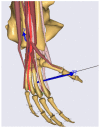Musculoskeletal Modeling of the Wrist via a Multi Body Simulation
- PMID: 35455073
- PMCID: PMC9031395
- DOI: 10.3390/life12040581
Musculoskeletal Modeling of the Wrist via a Multi Body Simulation
Abstract
In this study, three different musculoskeletal modeling approaches were compared to each other. The objective was to show the possibilities in the case of a simple mechanical model of the wrist, using a simple multi-body-simulation (MBS) model, and using a more complex and patient-specific adaptable wrist joint MBS model. Musculoskeletal modeling could be a useful alternative, which can be practiced as a non-invasive approach to investigate body motion and internal loads in a wide range of conditions. The goal of this study was the introduction of computer-based modelling of the physiological wrist with (MBS-) models focused on the muscle and joint forces acting on the wrist.
Keywords: MBS; biomechanics; modeling; total wrist arthroplasty.
Conflict of interest statement
The authors declared no potential conflict of interest concerning the research, authorship, and/or publication of this article.
Figures













References
-
- Schmidt H.-M., Lanz U. Chirurgische Anatomie der Hand. 2nd ed. Thieme; Stuttgart, Germany: 2003.
Grants and funding
LinkOut - more resources
Full Text Sources

